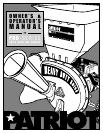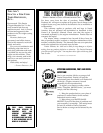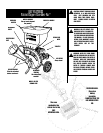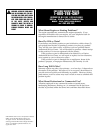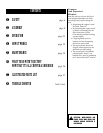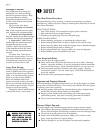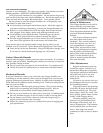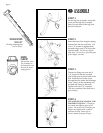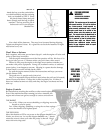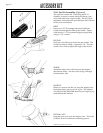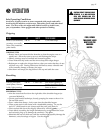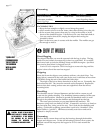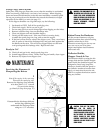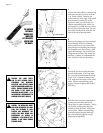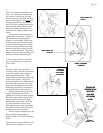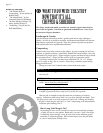
Fire and Burn Hazards
Gasoline is very flammable. The vapor can explode. Use extreme care when
handling gasoline. KEEP FUEL AWAY FROM CHILDREN.
Use a proper fuel container for your gasoline. Do not remove the gas cap
until you have shut down the chipper-shredder-vac. Re-fuel the engine out of
doors and only after the engine has cooled down. Use a gasoline funnel.
Do not operate or store the chipper-shredder-vac, or the gasoline, near
open flames or other heat sources.
▲ Avoid touching a hot engine and exhaust system. Allow the engine to
cool before refueling, transporting, or storing the chipper-shredder-vac.
▲ Refuel in a well-ventilated area with the engine shut off and the rotor
fully stopped. Keep flames, sparks, and smoking materials away!
▲ Avoid spilling or over-filling the tank. Tighten the gas cap after re-
fueling. Allow spilled fuel to dry before re-starting the engine.
▲ Store the chipper-shredder-vac on a level surface in a well-ventilated
area, away from appliances like water heaters and clothes drier.
Grass and dry leaves are also flammable. Empty the bag when you are
finished, even if it is not full. Stored shreds and clippings are a fire hazard.
▲ Grass and dry leaves are flammable. Empty the bag before storage, even
if it is not full. Stored shreds and clippings are a fire hazard.
Carbon Monoxide Hazards
Exhaust from the engine contains poisonous carbon monoxide. It is colorless,
odorless, and can be lethal. Breathing the exhaust can cause loss of conscious-
ness, possibly leading to death.
▲ Do not operate any gas engine in an enclosed area. Use outdoors only!
▲ Carbon monoxide is a poison known to cause cancer and birth defects.
Mechanical Hazards
If unusual vibration or noise occurs, shut down the chipper-shredder-vac.
Continuing to run the machine when it may be damaged may cause serious
property damage and personal injury. Replace or repair parts as needed and
check fasteners for tightness before resuming work. If there are still problems,
take it to a service shop.
▲ Don’t tamper with the engine speed governors. They prevent rotating
parts from over-speeding and causing damage or injury. Seek an
authorized service mechanic should engine problems arise.
▲ Do not put your hands or any other part of your body or clothing inside
the cone, shredder hopper, or into any inlet or outlet to moving parts!
▲ Do not attempt even a minor clean-out of the cone, hopper, bag, or
engine service while the rotor is turning!
▲ Empty the collection bag when it is almost full to prevent clogging and
poor performance.
page 7
Safety & Maintenance
This chipper-shredder-vac is built to
meet or beat the very latest safety
standards established by the Outdoor
Power Equipment Institute and the
American National Standards
Institute.
Part of this certification requires
that safety labels meet certain
standards. They must be replaced
when they become worn out. It is
your responsibility to replace the
labels if they become hard to read.
Safety certification also requires
that all guards and deflectors be
kept in place and in good condition.
Again, it is the operator’s job to
repair or replace guards and deflec-
tors when necessary.
Other Maintenance
Regular maintenance must also
include the engine. Add oil as it is
needed and change the oil regularly.
Your engine manual has information
about the kind of oil to use, how
much to use, and how to add or
drain the oil.
It’s hard to say exactly when you
should sharpen the knives or replace
the shredding hammers.
Chipping branches and prunings
while they are green and fresh keeps
the knives wet and cool. They stay
sharp longer. Dead, dry wood—and
dirty, gravelly garden waste, for that
matter—dulls chipping knives.
Generally speaking, when the
knives do not pull branches down
the chipper with relative ease, it is
time to sharpen them. The hammers
can be checked after you have shut
down. If the edges are smooth,
weathered or bent, reverse or replace
them.



